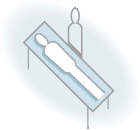- Case History
- Nursing Records
- Clinical Appearance
- Investigations
- Questions
- Answers
Questions:
1) What physical signs should you look?
2) What should you try and measure?
3) What emergency procedure is necessary to save his sight?
4) What are the indications/contraindications?
5) What instruments do you need?
6) How do you perform it?
Answers:
1) Check visual acuity, pupillary reflexes, eye movements, look for proptosis.
2) Intraocular pressure (normal up to 20 mmHg) by tonometry if available or manual globe palpation over a closed lid.
3) Lateral canthotomy and inferior cantholysis.
4) Indications:
a. Primary - decreased VA/ intraocular pressure >40/ proptosis.
b. Secondary – afferent papillary defect/ opthalmoplegia/ disc pallor on fundoscopy.
Contraindications: ruptured globe
5) Lignocaine with adrenaline + 2ml syringe with orange needle/ artery forceps/ straight short scissors/ forceps
6) http://www.brown.edu/Administration/Emergency_Medicine/eye.htm
Step 1: Clear debris and secretions away from around the lateral canthus and the surrounding skin with normal saline. If the patient is awake, an assistant should stabilize the head (left/right lateral position may be most comfortable for both patient and operator).
Step 2: Inject 1 ml of local anaesthetic into the lateral canthus. This provides both pain relief and some haemostasis at the time of devascularisation and incision.
Step 3: Insert the straight artery forceps from the lateral canthus towards the bony orbit and compress to devascularize the area for 10 seconds.
Step 4: Remove the straight artery forceps and cut the demarcated area laterally to the orbital margin.
Step 5: Using the forceps, pull the lower lid down to visualize the inferior lateral canthal tendon and cut through this tendon.
Step 6: Refer for urgent orbital decompression.


